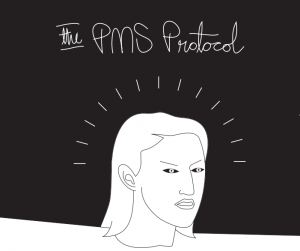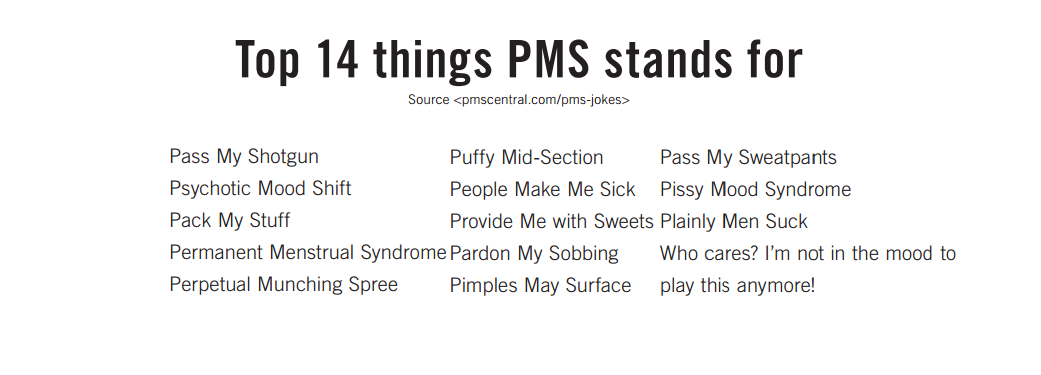My head aches. So does my abdomen. It’s 9:30 am and I’m ready for a nap. My neighbour’s coal roller frankentruck has been idling in the driveway for five minutes; I’m about to introduce it to my rolling pin. That SPCA commercial starring Sarah McLachlan just came on—the one that plays Angel—and I’ve started to cry. My boyfriend is baffled. Are these the thoughts and actions of a rational woman? What if that woman was in the grips of premenstrual syndrome (PMS)? “Ah,” he’d say, “that explains it.” Grab the flak jacket; it’s time to initiate The PMS Protocol.
Women are blessed with bodies that do wondrous things, like growing babies, but we need hormones to do it, and those levels fluctuate. The downside of dancing the hormonal tango is that it’s like a roller coaster of very real physical, chemical, and emotional side effects. Some, like periodically increased libido, are great. Others, like nausea-inducing multi-day migraines, abdominal bloating, and alternating waves of tears and rage, less so.
Women experience these things to different degrees. If you grew up ducking your mother when she was premenstrual, chances are your kids will be doing the same with you. So for those about to bleed, on the couch balling over a puppy food commercial, we salute you.
 Google “PMS” and one of the top hits will give you “Standard PMS Protocols.” Great. Unfortunately, that’s cisco.com, completely unhelpful on the topic of premenstrual syndrome (but offers a wide array of information on the topic of developing and coding). It’s worthwhile to note that, after researching an article like this, Google will return more relevant results.
Google “PMS” and one of the top hits will give you “Standard PMS Protocols.” Great. Unfortunately, that’s cisco.com, completely unhelpful on the topic of premenstrual syndrome (but offers a wide array of information on the topic of developing and coding). It’s worthwhile to note that, after researching an article like this, Google will return more relevant results.
Menstruation is as old as human reproduction, a very necessary part of the works. At one time, menstruating females were sent away from their tribes for fear that the powerful forces accompanying menstruation would challenge the magic of the shaman. Some see this as an isolating form of exile. I can’t help but wonder if those women didn’t do a happy dance on their way to The Hut. No responsibilities, just one mouth to feed, camaraderie, and plenty of time to nap or catch up on sewing. How many women would turn that down today?
I also wonder whether a woman’s greatest power comes at the time of menstruation, as the blood leaves her body, or if it’s actually stronger leading up to the flow? The power and emotion of the premenstrual phase is more likely to knock my boyfriend’s socks off than the crampy ball rolled up on the couch, whimpering requests for herbal tea and Pamprin. He has a good attitude towards menstruation, and is happy to oblige, but he finds the chaotic roller coaster in the week(s) before perplexing.
Whether it had a label or not, PMS is as old as menstruation itself. It affects about three out of four women, but didn’t get serious attention until the 1980s after it was used as a legal defense for the first time in Britain. In the decades since, it has slowly gained credibility in the medical community and society in general. Today, women are less likely to be told it’s, “All in their head.”
Many factors contribute to the cluster of symptoms labeled PMS. The change in hormones produces changes in brain chemistry, which plays a part in moods. Depression, fatigue, food cravings, and sleep disruptions are just the tip of the iceberg. Emotional symptoms include tension, crying spells, mood swings, and irritability. Physical symptoms also include headache, bloating, breast tenderness, acne, and joint pain. For some women, the emotional symptoms can cross the line and become debilitating, which brings a new diagnosis, a form of PMS called premenstrual dysphoric disorder (PMDD).
Home-grown treatments for PMS cover the full gamut from essential oils, juice fasts, detoxifying cleanses, fitness regimens, you name it. These all fall under basic self-care, lifestyle choices that can manage the symptoms. PMDD can require medical intervention, and sometimes psychiatric medication if it’s too debilitating. In either case, charting your cycle on a calendar is a good way to get a handle on things. When you see that window of days, block it out and make the conscious choice to go easy on yourself. Don’t make an appointment with the bank to renegotiate your mortgage. Ask your partner to take your son to swim practice and skip the brightly lit echo chamber with the shrieking synchronized swimming coach blasting tinny music through the sound system and keeping time by hammering a wooden counter on a metal bar over and over and over and over again. Why put yourself through that?
It’s during the premenstrual phase that I’m most likely to be deemed unfit for human contact. So where’s The PMS Hut? With a space of my own I could catch up on some reading, poke at the mending pile, knit a little, and nap when keeping my eyes open shoots daggers of pain into my brain. When the hormones stopped spiking, I’d emerge refreshed and altogether more capable of basic human kindness, rational in both thought and deed. Navigating my period would be a piece of cake. The benefits of supporting this little slice of self-care for women would far outweigh the costs. Think of the cost savings on therapy and divorce lawyers alone. Why not offer paid sick leave to sufferers of PMS? The idea comes up periodically for menstruating women (met by much clamour and gender politicking and general sulking from male workers), so why not apply it to PMS?
It isn’t just a women’s issue; it affects anyone within striking distance of a premenstrual woman’s sharp tongue. Countless websites are available for women seeking relief from their symptoms, or at the very least an understanding of why they feel like a monster has taken over their bodies each month. But where are the resources for the men?
Female reproduction, in general, tends to be utterly baffling to men. Even the dating site, <eharmony.com> includes a helpful page about PMS in their dating advice section. It’s only fair that men be offered a road map of sorts: The PMS Protocol. Adopting military vocabulary helps make the topic relatable while imparting the very solemn truth that this, in fact, can be like war. But it’s not personal: the hormones are the aggressors, while the suffering female is simply their innocent vessel.
It’s helpful for men to have a rudimentary understanding of how women’s brains work. For instance, women can seem psychic, but really, they’re just more attuned to facial expressions and subtleties like posture or tone of voice, all helpful when caring for preverbal infants. This sensitivity can also help women avoid conflict, which can be unbearable because the chemicals that flood the brain are akin to seizure activity. That aversion to conflict may have evolved as a way to avoid physical aggression, because children were more dependent on their mothers for survival. And just for kicks, women get to relive the tribulations of adolescence a second time, during perimenopause, which usually strikes in the late 40s. On the upside, after all is done, women seem to catch a second wind. Unfortunately, later in life tends to be the time their partners start winding down (hence the prevalence of women’s hiking groups).
No matter where a woman is on the continuum, open communication between everyone in a household or relationship will help to smooth things out if women are able to tell the men in their lives what’s going on and how they’re feeling. A simple statement like, “The woman before you may become a total stranger over the next week or so. It may seem like you’re dating/married to a sharp-tongued, emotionally unstable intruder, but please don’t take it personally. The forces at work here are invisible to the eye. But they’re very real. So please be nice, even when I’m not.” Also note: a woman may openly label herself a raving lunatic, but it is not recommended that anyone else take the liberty of speaking such things aloud.
The PMS Protocol is predicated on careful movement. Stress makes the symptoms worse. She may want you around, but she may also need space. Simultaneously. This has nothing to do with you. Surprises are best saved for another time. Keeping things simple is helpful; some women prefer to avoid social engagements until they’re feeling more personable (and perhaps a little less bloated so they can fit into their favourite jeans). If you notice changes in her diet, those are probably best left uncommented upon. She hasn’t forgotten that you’re both cutting the carbs, but if half a pizza is what she needs to take the edge off, just let it be. Where there’s room to be a little helpful, take on chores that she’d normally do, but do so without fanfare, without drawing attention to yourself. Such an act of kindness can make the difference between a slightly grey evening and one that is stormy black. We know it isn’t fair, it really isn’t your job to spend this time walking so softly, but you’ll find that the benefits outweigh the drawbacks if you do.
A variety of apps have been developed to provide alerts and reminders to men as their female partners/sisters/mothers/coworkers are approaching their fragile time. Forewarned is forearmed; grab the eggshell-shoes.
When it comes to female hormonal activity, PMS gets the spotlight, but a woman’s hormones fluctuate constantly during her cycle (that’s to say, all the time). At one point, the combination of hormones creates premenstrual symptoms. But there are other peaks and combinations as well. After menstruation, some women experience a period of euphoria. Down the line, closer to ovulation, women may feel flirtatious and sexier—this is biological preparation for ovulation and baby-making. Surges in estrogen and testosterone can kick the libido into high gear, so enjoy your sassy sexpot in her new miniskirt, and grab some romantic moments while the gettin’s good. This hormonal rollercoaster may not be a ride you signed up for, but there are thrills to be found along the way.

